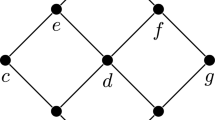Abstract
There is very little of “time” in a temporal constraint propagation algorithm. Most of these algorithms could easily handle reasoning over any domain mapable onto rational numbers, e.g., weight, frequency, luminosity, etc. Actually some of these algorithms are capable of handling more sophisticated domains than those mapped onto rational numbers, e.g., intervals, or partially ordered objects (say, time). In this article we have generalized such an algorithm, which was originally developed for time-interval domain, to any generic domain, where binary constraints are expressed over arcs of the constraint network. Given the composition table for the primitive relations between a pair of the domain entities (e.g., intervals) as an additional input along with a constraint graph, the algorithm would generate all consistent singleton models for a given network. The algorithm is also extended here to handle uncertainty values.
Similar content being viewed by others
References
L. Vila, “A survey on temporal reasoning in artificial intelligence,” Artificial Intelligence Communications, vol. 7, pp. 4–28, 1994.
L. Chittaro and A. Montanari, “Temporal representation and reasoning in artificial intelligence: Issues and approaches,” Annals of Mathematics and Artificial Intelligence, vol. 28, no. 1, pp. 47–106, 2000.
J. Renz and B. Nebel, “On the complexity of qualitative spatial reasoning: A maximal tractable fragment of the region connection calculus,” Artificial Intelligence, vol. 108, pp. 69–123, 1999.
J.F. Allen, “Maintaining knowledge about temporal intervals,” Communications of the ACM, vol. 26, no. 11, pp. 832–843, 1983.
R.M. Haralick and L.G. Shapiro, “Increasing tree search effi-ciency for constraint satisfaction problems,” Artificial Intelligence, vol. 14, pp. 263–313, 1980.
G. Kondrak and P. van Beek, “A theoretical evaluation of selected backtracking algorithms,” in Proc. of International Joint Conference on AI, 1995, pp. 541–547.
D. Mitra, “All consistent temporal models for hybrid representation of temporal entities,” in Proceedings of Conference on Information Technology, 1998, Tata-McGraw Hill: New Delhi, India.
P.B. Ladkin and A. Reinefield, “Effective solution of qualitative interval constraint problems,” Artificial Intelligence, vol. 57, pp. 105–124, 1992.
R. Dechter, I. Meiri, and J. Pearl, “Temporal constraint networks,” Artificial Intelligence, vol. 49, pp. 61–95, 1991.
U. Montanari, “Networks of constraints: Fundamental properties and applications to picture processing,” Information Sciences, vol. 7, pp. 95–132, 1974.
P. Balbiani and A. Osmani, “A model for reasoning about topological relations between cyclic intervals,” in Proceedings of the Seventh International Conference on Principles of Knowledge Representation and Reasoning, 2000.
D. Mitra, P. Srnivasan, M.L. Gerard, and A.E. Hands, “A probabilistic interval constraint problem: Fuzzy temporal reasoning,” in World Congress on Computational Intelligence (FUZZIEEE'94), 1994.
Author information
Authors and Affiliations
Rights and permissions
About this article
Cite this article
Mitra, D. A Path-Consistent Singleton Modeling (CSM) Algorithm for Arc-Constrained Networks. Applied Intelligence 17, 313–318 (2002). https://doi.org/10.1023/A:1020095501462
Issue Date:
DOI: https://doi.org/10.1023/A:1020095501462




